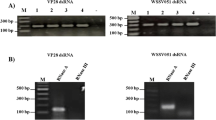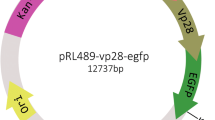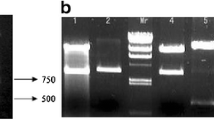Abstract
Aquacultural shrimps suffer economic lost due to the white spot syndrome virus (WSSV) that is the most notorious virus for its fatality and contagion, leading to a 100% death rate on infected shrimps within 7 days. However, the infection of mechanism remains a mystery and crucial problem. To elucidate the pathogenesis of WSSV, a high abundance of protein is required to identify and characterize its functions. Therefore, the optimal WSSV355 overexpression was explored in engineered Escherichia coli strains, in particular C43(DE3) as a toxic tolerance strain remedied 40% of cell growth from BL21(DE3). Meanwhile, a trace amount of WSSV355 was observed in both strains. To optimize the codon of WSSV355 using codon adaption index (CAI), an overexpression was observed with 1.32 mg/mL in C43(DE3), while the biomass was decreased by 35%. Subsequently, the co-expression with pRARE boosted the target protein up to 1.93 mg/mL. Finally, by scaling up production of WSSV355 in the fermenter with sufficient oxygen supplied, the biomass and total and soluble protein were enhanced 67.6%, 44.9%, and 7.8% compared with that in flask condition. Herein, the current approach provides efficacious solutions to produce toxic proteins via codon usage, strain selection, and processing optimization by alleviating the burden and boosting protein production in E. coli.





Similar content being viewed by others
Data Availability
Data will be made available on reasonable request.
Ethics Approval, Consent to Participate and Publication.
All the authors have read and agreed the ethics for publishing the manuscript.
References
Durand, S., Lightner, D. V., Nunan, L. M., Redman, R. M., Mari, J., & Bonami, J. R. (1996). Application of gene probes as diagnostic tools for white spot baculovirus (WSBV) of penaeid shrimp. Diseases of Aquatic Organisms, 27(1), 59–66.
Kumar, R., Huang, J. Y., Ng, Y. S., Chen, C. Y., & Wang, H. C. (2022). The regulation of shrimp metabolism by the white spot syndrome virus (WSSV). Reviews in Aquaculture, 14(3), 1150–1169.
Li, C., Weng, S., & He, J. (2019). WSSV–host interaction: Host response and immune evasion. Fish & Shellfish Immunology, 84, 558–571.
Patil, P. K., Geetha, R., Ravisankar, T., Avunje, S., Solanki, H. G., Abraham, T. J., Vinoth, S. P., Jithendran, K. P., Alavandi, S. V., & Vijayan, K. K. (2021). Economic loss due to diseases in Indian shrimp farming with special reference to Enterocytozoon hepatopenaei (EHP) and white spot syndrome virus (WSSV). Aquaculture, 533, 736231.
Liu, L. K., Liu, M. J., Li, D. L., & Liu, H. P. (2021). Recent insights into anti-WSSV immunity in crayfish. Developmental & Comparative Immunology, 116, 103947.
Xu, T., Shan, X., Li, Y., Yang, T., Teng, G., Wu, Q., Wang, C., Tang, K. F. J., Zhang, Q., & Jin, X. (2021). White spot syndrome virus (WSSV) prevalence in wild crustaceans in the Bohai Sea. Aquaculture, 542, 736810.
Oakey, H. J., & Smith, C. S. (2018). Complete genome sequence of a white spot syndrome virus associated with a disease incursion in Australia. Aquaculture, 484, 152–159.
Leu, J. H., Yang, F., Zhang, X., Xu, X., Kou, G. H., & Lo, C. F. (2009). Whispovirus. Lesser known large dsDNA. Viruses, 197–227.
Xie, X., Li, H., Xu, L., & Yang, F. (2005). A simple and efficient method for purification of intact white spot syndrome virus (WSSV) viral particles. Virus Research, 108(1–2), 63–67.
Alemdar, S., Hartwig, S., Frister, T., König, J. C., Scheper, T., & Beutel, S. (2016). Heterologous expression, purification, and biochemical characterization of α-humulene synthase from Zingiber zerumbet Smith. Applied Biochemistry and Biotechnology, 178(3), 474–489.
Mahamad, P., Boonchird, C., & Panbangred, W. (2016). High level accumulation of soluble diphtheria toxin mutant (CRM197) with co-expression of chaperones in recombinant Escherichia coli. Applied Microbiology and Biotechnology, 100(14), 6319–6330.
Ajayi, B. O., Olajide, T. A., & Olayinka, E. T. (2022). 6-Gingerol attenuates pulmonary inflammation and oxidative stress in mice model of house dust mite-induced asthma. Advances in Redox Research, 5, 100036.
Gumpena, R., Lountos, G. T., & Waugh, D. S. (2018). MBP-binding DARPins facilitate the crystallization of an MBP fusion protein. Acta Crystallographica Section F: Structural Biology Communications, 74(9), 549–557.
Kim, D. S., Kim, S. W., Song, J. M., Kim, S. Y., & Kwon, K. C. (2019). A new prokaryotic expression vector for the expression of antimicrobial peptide abaecin using SUMO fusion tag. BMC biotechnology, 19(1), 1–12.
Hemmati, S., & Ranjbari, J. (2019). Soluble form production of recombinant human insulin-like growth factor-1 by NusA fusion partner in E. coli. Trends in Peptide and Protein Sciences, 4, 1–5.
Yu, T. H., Tan, S. I., Yi, Y. C., Xue, C., Ting, W. W., Chang, J. J., & Ng, I. S. (2022). New insight into the codon usage and medium optimization toward stable and high-level 5-aminolevulinic acid production in Escherichia coli. Biochemical Engineering Journal, 177, 108259.
Fu, H., Liang, Y., Zhong, X., Pan, Z., Huang, L., Zhang, H., Xu, Y., Zhou, W., & Liu, Z. (2020). Codon optimization with deep learning to enhance protein expression. Scientific Reports, 10(1), 1–9.
Wang, H. C., Wang, H. C., Kou, G. H., Lo, C. F., & Huang, W. P. (2007). Identification of icp11, the most highly expressed gene of shrimp white spot syndrome virus (WSSV). Diseases of Aquatic Organisms, 74(3), 179–189.
Ting, W. W., Yu, J. Y., Lin, Y. C., & Ng, I. S. (2022). Enhanced recombinant carbonic anhydrase in T7RNAP-equipped Escherichia coli W3110 for carbon capture storage and utilization (CCSU). Bioresource Technology, 128010.
Teufel, F., Armenteros, J. J. A., Johansen, A. R., Gíslason, M. H., Pihl, S. I., Tsirigos, K. D., Winther, O., Brunak, S., Heijne, G., & Nielsen, H. (2022). SignalP 6.0 predicts all five types of signal peptides using protein language models. Nature Biotechnology, 40, 1023–1025.
Effendi, S. S. W., Tan, S. I., Ting, W. W., & Ng, I. S. (2021). Genetic design of co-expressed Mesorhizobium loti carbonic anhydrase and chaperone GroELS to enhancing carbon dioxide sequestration. International Journal of Biological Macromolecules, 167, 326–334.
Zhang, Z. X., Nong, F. T., Wang, Y. Z., Yan, C. X., Gu, Y., Song, P., & Sun, X. M. (2022). Strategies for efficient production of recombinant proteins in Escherichia coli: Alleviating the host burden and enhancing protein activity. Microbial Cell Factories, 21, 191.
Ting, W. W., Tan, S. I., & Ng, I. S. (2020). Development of chromosome-based T7 RNA polymerase and orthogonal T7 promoter circuit in Escherichia coli W3110 as a cell factory. Bioresources and Bioprocessing, 7, 54.
Mittal, P., Brindle, J., Stephen, J., Plotkin, J. B., & Kudla, G. (2018). Codon usage influences fitness through RNA toxicity. Proceedings of the National Academy of Sciences, 115(34), 8639–8644.
Schlegel, S., Genevaux, P., & de Gier, J. W. (2015). De-convoluting the genetic adaptations of E. coli C41 (DE3) in real time reveals how alleviating protein production stress improves yields. Cell Reports, 10(10), 1758–1766.
Effendi, S. S. W., Xue, C., Tan, S. I., & Ng, I. S. (2021). Whole-cell biocatalyst of recombinant tyrosine ammonia lyase with fusion protein and integrative chaperone in Escherichia coli for high-level p-Coumaric acid production. Journal of the Taiwan Institute of Chemical Engineers, 128, 64–72.
Liu, Y. (2020). A code within the genetic code: Codon usage regulates co-translational protein folding. Cell Communication and Signaling, 18(1), 1–9.
Silva, F., Queiroz, J. A., & Domingues, F. C. (2012). Evaluating metabolic stress and plasmid stability in plasmid DNA production by Escherichia coli. Biotechnology Advances, 30, 691–708.
Yi, Y. C., Xue, C., & Ng, I. S. (2021). Low-carbon-footprint production of high-end 5-aminolevulinic acid via integrative strain engineering and RuBisCo-equipped Escherichia coli. ACS Sustainable Chemistry & Engineering, 9(46), 15623–15633.
Takahashi, M., & Aoyagi, H. (2020). Analysis and effect of conventional flasks in shaking culture of Escherichia coli. AMB Express, 10(1), 1–6.
Crofts, A. A., Giovanetti, S. M., Rubin, E. J., Poly, F. M., Gutiérrez, R. L., Talaat, K. R., Porter, C. K., Mark, S., DeNearing, B., Brubaker, J., Maciel, M., Jr., Alcala, A. N., Chakraborty, S., Prouty, M. G., Savarino, S. J., Davies, B. W., & Trent, M. S. (2018). Enterotoxigenic E. coli virulence gene regulation in human infections. Proceedings of the National Academy of Sciences, 115(38), E8968–E8976.
Akisue, R. A., Horta, A. C., & de Sousa Jr, R. (2018). Development of a fuzzy system for dissolved oxygen control in a recombinant Escherichia coli cultivation for heterologous protein expression. In Computer Aided Chemical Engineering (Vol. 43, pp. 1129–1134). Elsevier.
Saito, Y., Kitagawa, W., Kumagai, T., Tajima, N., Nishimiya, Y., Tamano, K., Yasutake, Y., Tamura, T., & Kameda, T. (2019). Developing a codon optimization method for improved expression of recombinant proteins in actinobacteria. Scientific Reports, 9(1), 1–10.
Mauro, V. P. (2018). Codon optimization in the production of recombinant biotherapeutics: Potential risks and considerations. BioDrugs, 32(1), 69–81.
Huang, P., Shi, J., Sun, Q., Dong, X., & Zhang, N. (2018). Engineering Pichia pastoris for efficient production of a novel bifunctional Strongylocentrotus purpuratus invertebrate-type lysozyme. Applied Biochemistry and Biotechnology, 186(2), 459–475.
Coenen, A., Marti, V. G., Müller, K., Sheremetiev, M., Finamore, L., & Schörken, U. (2022). Synthesis of polymer precursor 12-oxododecenoic acid utilizing recombinant papaya hydroperoxide lyase in an enzyme cascade. Applied Biochemistry and Biotechnology, 1–19.
Yang, H., Jiang, Y., Lu, K., Xiong, H., Zhang, Y., & Wei, W. (2021). Herbicide atrazine exposure induce oxidative stress, immune dysfunction and WSSV proliferation in red swamp crayfish Procambarus clarkii. Chemosphere, 283, 131227.
Jiang, H. F., Chen, C., Jiang, X. Y., Shen, J. L., Ling, F., Li, P. F., & Wang, G. X. (2022). Luteolin in Lonicera japonica inhibits the proliferation of white spot syndrome virus in the crayfish Procambarus clarkii. Aquaculture, 550, 737852.
Funding
The study was financially supported by the Ministry of Science and Technology (MOST 110–2221-E-006–030-MY3 and MOST 111–2221-E-006–012-MY3) in Taiwan.
Author information
Authors and Affiliations
Contributions
Ying-Chen Yi and I-Son Ng conceived the study. Po-Yen Chen performed all the experiments and sketched the original draft. Han-Ching Wang provided the original DNA of WSSV355. I-Son Ng did methodology validation, supervised the experiments, reviewed, and edited the manuscript.
Corresponding author
Ethics declarations
Conflict of Interest
The authors declare no competing interests.
Additional information
Publisher's Note
Springer Nature remains neutral with regard to jurisdictional claims in published maps and institutional affiliations.
Supplementary Information
Below is the link to the electronic supplementary material.
Rights and permissions
Springer Nature or its licensor (e.g. a society or other partner) holds exclusive rights to this article under a publishing agreement with the author(s) or other rightsholder(s); author self-archiving of the accepted manuscript version of this article is solely governed by the terms of such publishing agreement and applicable law.
About this article
Cite this article
Chen, PY., Yi, YC., Wang, HC. et al. Heterologous Expression of Toxic White Spot Syndrome Virus (WSSV) Protein in Eengineered Escherichia coli Strains. Appl Biochem Biotechnol 195, 4524–4536 (2023). https://doi.org/10.1007/s12010-023-04369-1
Accepted:
Published:
Issue Date:
DOI: https://doi.org/10.1007/s12010-023-04369-1




